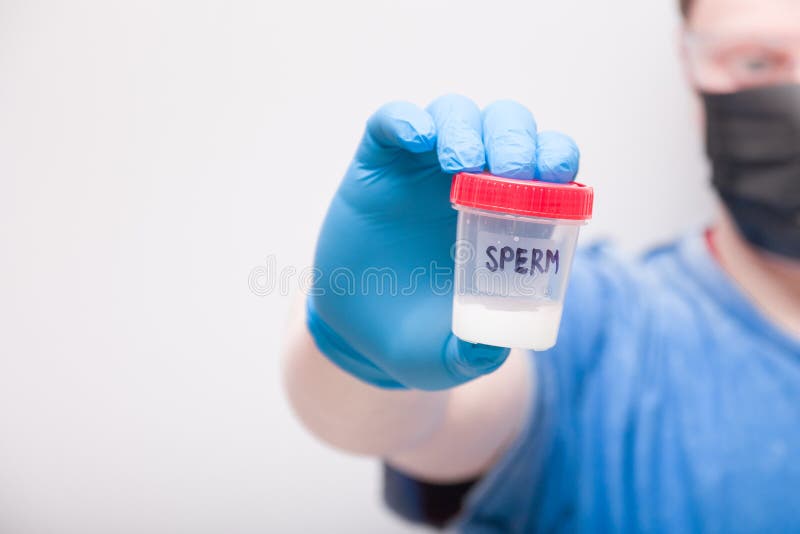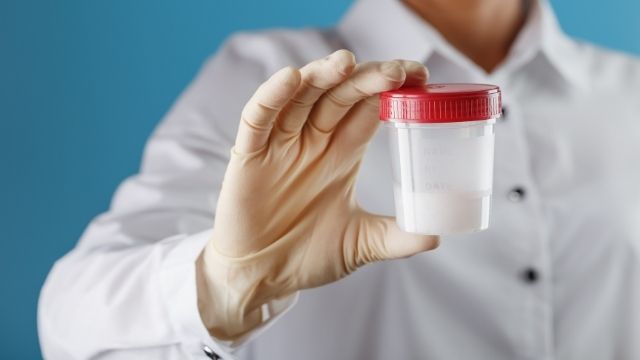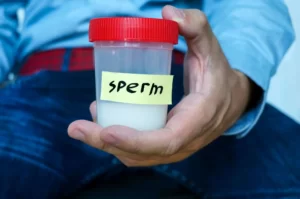What is Aspermia? | Aspermia Symptoms, Causes & Treatment
A variety of reasons, including retrograde ejaculation, ejaculatory duct occlusion, and anejaculation, may contribute to the disease.
Aspermia may arise as a consequence of surgical operations performed in the past, nerve damage caused by illness, or congenital cysts, all of which are treatable conditions.
Table of Contents
What is Aspermia?
Infertility in males is caused by a disease known as aspermia, which limits the release of sperm from the testicles. Although aspermia does not cause low sperm counts, it does cause an absence of the ejaculated fluid as a whole in men.
Depending on the underlying reason as well as the comprehensive diagnosis, the therapy for this ailment may vary. It is possible for men suffering from this illness to experience orgasm despite the lack of ejaculation.
Aspermia is defined by the entire lack of semen, which implies that men with aspermia cannot ejaculate at all. The volume of sperm is nil.
It is critical not to confuse aspermia with azoospermia. Aspermia is the entire lack of sperm upon ejaculation, whereas azoospermia is the full absence of sperm in sperm and is one of the leading reasons of male infertility.
Aspermia is a relatively unusual disorder in which males are unable to ejaculate and hence generate a sperm sample, even for seminal examination.
This can happen even if you can achieve an erection and have typical coitus and orgasm without any other issues.
While anejaculation can be caused by a psychological issue (when a man is unable to achieve orgasm despite having an erection), the most common reason for aspermia diagnosis is the condition of retrograde ejaculation or ejaculatory duct obstruction – for example, mechanical obstruction in the testes.
Retrograde Ejaculation
Retrograde ejaculation occurs when the urine bladder neck fails to close, resulting in backward ejaculation of sperm into the urinary bladder rather than forward.
This is determined based on orgasm history without ejaculation (a “dry run”). Post-ejaculatory urine study confirms the diagnosis; a high concentration of sperm in the urine shows issues with the bladder neck sphincter.
However, sperm from urine may be collected and utilised in artificial reproduction procedures (ART) to fertilise eggs and create embryos.
The MESA (microscopic epididymal sperm aspiration) method is typically employed in males with retrograde ejaculation to harvest sperm for use in ART.
Ejaculatory Duct Obstruction ( EDO )
Ejaculatory duct occlusion is a condition in which one or both ejaculatory ducts are blocked. In the presence of bilateral ejaculatory duct blockage (obstruction of both ejaculatory ducts), we refer to Complete EDO; in the absence of obstruction of just one ejaculatory duct, we refer to Partial EDO; nevertheless, the indications for evaluation of Partial EDO are debatable.
On rectal examination, enlarged palpable seminal vesicles can be used to assess the amount of ejaculatory duct blockage.
If the ejaculate volume is less than 1 mL, the pH is less than 7.0, and there is no sperm or fructose, the diagnosis is proposed.
It is also validated by Transrectal Ultrasonography of the Prostate (TRUS) assessment, vosography, or transrectal injection of contrast media into the seminal vesicles.
Mechanical blockages can be medically rectified, but if there is no sperm production in the testes at all, this will result in infertility. However, some artificial reproduction procedures may be useful in achieving fertilisation.
Aspermia Impact On Fertility
Mechanical blockage of the ejaculatory ducts or epididymal obstruction prevents ejaculate outflow or, in the case of retrograde ejaculation, ejaculate flows backward to the urinary bladder.
As a result, ejaculation during intercourse is not feasible, there is no ejaculate, and the sperm does not reach the egg in the uterus.
Without surgery to remove the impediment or the use of ART, the chances of spontaneously conceiving are slim.
Symptoms of Aspermia
The most prominent symptom is the total lack of sperm following ejaculation, which is the most serious. Another set of signs that suggest that a guy may be suffering from the ailment are as follows:
- Whether or whether there is any blood present in the sperm is unknown.
- Anejaculation
- Discomfort in the scrotum, genital pain, and urinary pain are all symptoms of PCOS.
- Urine that is cloudy after a sexual encounter
Risks in Aspermia
Aspermia is associated with a number of risk factors, all of which must be addressed in conjunction with the therapy of this illness. The following are risk factors:
- Prostate gland inflammation is a medical condition that affects men.
- Disease that is present at birth
- Multiple sclerosis (MS) is a disease that affects the nervous system.
- Parkinson’s disease is a neurological disorder that affects movement.
- The urethra is somewhat obstructed.
- Trauma to the testicles
Prevention
Urinary tract infections may increase the likelihood of ejaculatory blockage, and as a result, they should be treated with antibiotics as soon as the infection is detected.
To a certain degree, this may avoid aspermia caused by an obstruction in the track. There is, however, no way to prevent the remaining reasons from occurring.
Treatment
Depending on the specific cause of the disease, a variety of techniques may be used to alleviate the symptoms of the condition. Surgical techniques, anti-infection medications, and artificial insemination are among the therapeutic options available.
Intracytoplasmic Sperm Injections are one kind of assisted reproductive technique that may help a fertile woman get pregnant if she is unable to conceive naturally.
Therapies
Self-Therapy
Semen is viewed as a type of bodily essence in traditional Chinese medicine, and it is said that the kidneys and liver play an essential role in storing the function of male reproductive organs.
Thus, the presence of blood in sperm is intimately connected to the health of the kidneys and liver. Herbal therapy for blood in the sperm is used as a treatment and is guided by bleeding symptoms principles.
Conventional Medicine
The antibiotic therapy may be used to treat urinary tract infection. The surgical method is typically used to treat retrograde ejaculation or Edo.
Pharmacotherapy
Inflammatory processes are treated with antibiotics.
In males with partial neurological impairments, alpha-agonists such as ephedrine may be taken before coitus to produce normal ejaculation (such as diabetes mellitus).
Sodium bicarbonate is used to manage urinary pH and osmolarity, as well as to reduce harmful effects on sperm cells collected from post-orgasmic urine for subsequent ART procedures of fertilisation.
Surgical treatment
The Transurethral Resection of the Ejaculatory Ducts (TURED) approach is used to treat ejaculatory duct blockage, and it has become a routine operation in this diagnosis. The resection may differ based on the severity of the obstruction’s circumstances.

In cases of lengthy post-inflammatory blockage, it may range from incising the cyst to relieve extrinsic pressures on the ducts to thorough excision along the channels.
Substantial resection of ejaculatory ducts may result in ejaculatory ducts opening into the urethra and urine reflux to the vasa; consequently, extensive resection should be done with caution.
Assisted Reproduction
If conservative medical procedures fail to result in a full-term pregnancy, the doctor may recommend that the patient undergo in vitro fertilisation (IVF). IVF and ART often begin with ovaries stimulation to boost egg production.
The majority of fertility drugs work by stimulating the formation of follicles in the ovary.
Gonadotropins and gonadotropin-releasing hormone are two examples. Following stimulation, the doctor surgically takes one or more eggs from the ovary and combines them with sperm in a laboratory environment in order to produce one or more embryos.
Fertilization occurs outside the body, and the fertilised egg is reinserted into the woman’s reproductive system via an embryo transfer process.
Intracytoplasmic sperm injection (ICSI) is useful in cases of male factor infertility if sperm counts are very low or prior IVF attempts failed to fertilise (s).
A single sperm is precisely inserted into the centre of an egg using a microneedle during the ICSI technique. ICSI requires just one sperm per egg. You’ll need between 50,000 and 100,000 without ICSI.
Men who ejaculate no sperm due to clogged tubes in their testes or a genetic issue that stops their sperm from being released require surgical sperm retrieval in order for ICSI to take place.
In ICSI therapy, epididymal sperm acquired using microsurgical aspiration (MESA) or percutaneous sperm aspiration (PESA) and testicular sperm retrieved through surgical excision (TESE) or percutaneous aspiration (TESA) are employed.
The collected sperm can also be cryopreserved for future sperm injection attempts. If all attempts to extract critical sperm cells fail, donated sperm cells may be considered.
Aspermia vs Azoospermia
The truth is that both azoospermia and aspermia dramatically lower a man’s chances of fathering a child. Although one is classed as an abnormal sperm production disease and the other as an ejaculatory problem, treatment choices for both might be comparable.

The preferred therapeutic method for non-obstructive azoospermia and anejaculation is sperm retrieval followed by ARTs. Unfortunately, ARTs are expensive and can be emotionally draining.
They also include artificial hormone stimulation and egg retrieval for the female partner.
Men with obstructive azoospermia may benefit from surgical blockage removal, reducing the requirement for sperm retrieval and ART; while men with retrograde ejaculation may benefit from medication.


